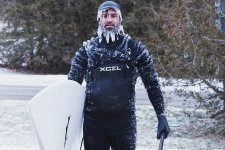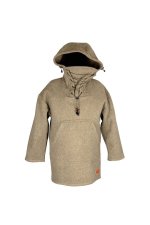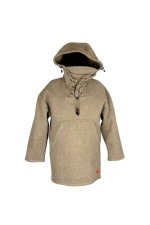Somewhat sheepishly, I confess to being a little woolly-headed about this topic. Are all you folks talking about canoeing in these various arctic wool togs? I've lived all over the USA, and everywhere I've been the fresh canoeing waters freeze before the climate becomes arctic.
I've canoed in the 30's F with maybe some dips into the 20's F before ice-over or after ice-out, especially in the rivers of the Sierra Nevada and New England mountains. But in just about all those cases I've worn either a wet suit with synthetics over it or, after 1985, a dry suit with with synthetics underneath. Now, I don't paddle in such temperatures anymore. I always felt sorry and even scared for the then old-timers who would dump in frigid waters wearing wool pants and jackets, which would become dangerously heavy and saggy and hard to wring-out when saturated.
In borderline temperatures on flat water, when I don't want to wear a full or partial dry suit, I wear layers of cotton and synthetics with a change thereof and a synthetic towel in a dry bag.
If we're just talking about general outdoor clothing for cold winter conditions, unrelated to canoeing, that's a different subject. For that, I've never personally cared for wool. Too scratchy, heavy and expensive for good stuff, except for some thin wool dress socks and one thin wool stocking cap I do like and have used for decades. Otherwise, I like layering in cottons and synthetics. They feel and smell nicer to me, and the synthetics are especially easy to dry out.
I also like my lightweight down parka for general winter use, unrelated to water sports.
I do need a new pair of winter gloves. I never liked wool gloves as a kid. They didn't keep out cold winds and too much wet snow would stick to the wool fibers when making snowballs to throw at buses. In 1983 I bought one of the very first pairs of Goretex gloves lined with Thermax on the market, and have been using the same pair for all winter recreational and work activities since, including whitewater canoeing in the 80's before I changed to nitrile gloves. That pair now has holes in the finger tips and I need to buy a replacement. But I'm shocked, shocked, shocked at the price increase for that same material 37 years later.
I've canoed in the 30's F with maybe some dips into the 20's F before ice-over or after ice-out, especially in the rivers of the Sierra Nevada and New England mountains. But in just about all those cases I've worn either a wet suit with synthetics over it or, after 1985, a dry suit with with synthetics underneath. Now, I don't paddle in such temperatures anymore. I always felt sorry and even scared for the then old-timers who would dump in frigid waters wearing wool pants and jackets, which would become dangerously heavy and saggy and hard to wring-out when saturated.
In borderline temperatures on flat water, when I don't want to wear a full or partial dry suit, I wear layers of cotton and synthetics with a change thereof and a synthetic towel in a dry bag.
If we're just talking about general outdoor clothing for cold winter conditions, unrelated to canoeing, that's a different subject. For that, I've never personally cared for wool. Too scratchy, heavy and expensive for good stuff, except for some thin wool dress socks and one thin wool stocking cap I do like and have used for decades. Otherwise, I like layering in cottons and synthetics. They feel and smell nicer to me, and the synthetics are especially easy to dry out.
I also like my lightweight down parka for general winter use, unrelated to water sports.
I do need a new pair of winter gloves. I never liked wool gloves as a kid. They didn't keep out cold winds and too much wet snow would stick to the wool fibers when making snowballs to throw at buses. In 1983 I bought one of the very first pairs of Goretex gloves lined with Thermax on the market, and have been using the same pair for all winter recreational and work activities since, including whitewater canoeing in the 80's before I changed to nitrile gloves. That pair now has holes in the finger tips and I need to buy a replacement. But I'm shocked, shocked, shocked at the price increase for that same material 37 years later.



